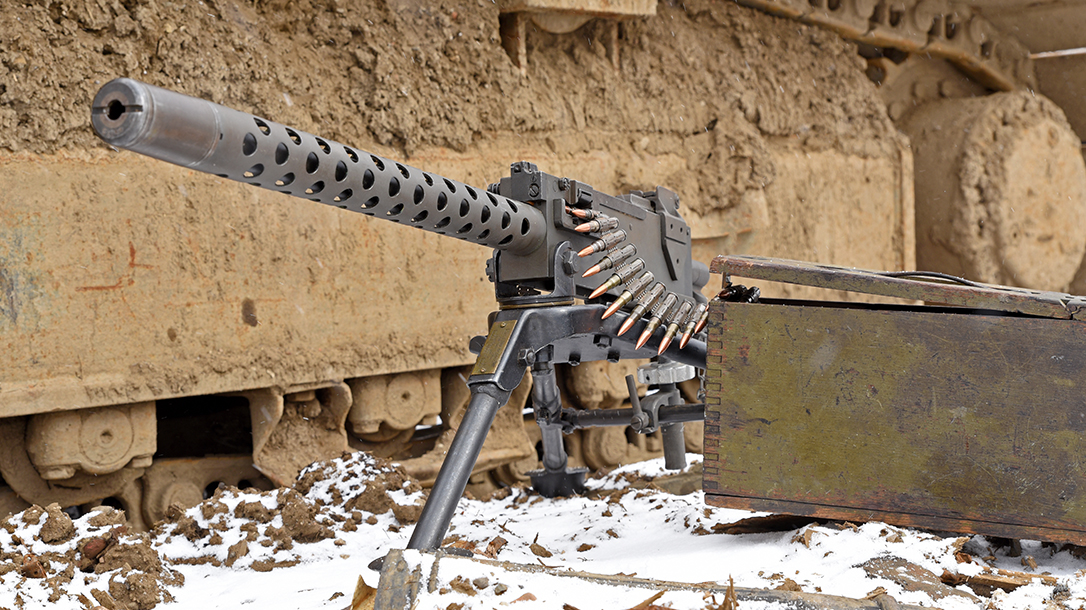Out of the ashes of First World War came the Thompson submachine gun, a firearm that could rightfully be considered the granddaddy of black guns. Yet another weapon was introduced in 1919 and, now 100-plus years later, it still remains in use throughout parts of the world—the U.S. M1919 machine gun designed by John Moses Browning (1855-1926).
U.S. M191 Machine Gun
To this day, Browning has remained one of America’s most prolific and successful firearms designers of the 19th and 20th Centuries. He pioneered the development of modern automatic and semi-automatic firearms and was awarded 128 firearms patents—the first when he was just 24 years old.
JMB Backstory
Among the final weapons he designed was the U.S. M1919 air-cooled, recoil-operated machine gun, a weapon that improved upon his earlier designs that went back nearly a quarter century. It was however, not his first foray into automatic weapons.
Advertisement — Continue Reading Below
While Browning had already successfully developed various lever-action rifles, as well as revolvers and pistols, he and his brother Matthew S. Browning were also among the early pioneers in firearms design to devise a gas-operated machine gun. Developed in 1889 with a patent filed in 1892, it would become the Colt-Browning M1895, a machine gun that would earn the nickname “potato digger” due to its unusual operating mechanism, one that caused the breechblock to slide rearward to eject a spent round.
The M1895 was the first machine gun to be adopted by the United States military even though it was never adopted officially by the United States Army. It was used by the U.S. Navy for its Naval Infantry as well as the United States Marine Corps and it saw use during the 1898 invasion of Guantanamo Bay during the Spanish-American War. Two M1895 machine guns were also supplied to Lt. Colonel Theodore Roosevelt’s Rough Riders—purchased by the East Coast socialites George and Isabella Tiffany for their son William Tiffany, and thus were forever nicknamed as the “Tiffany Guns.”
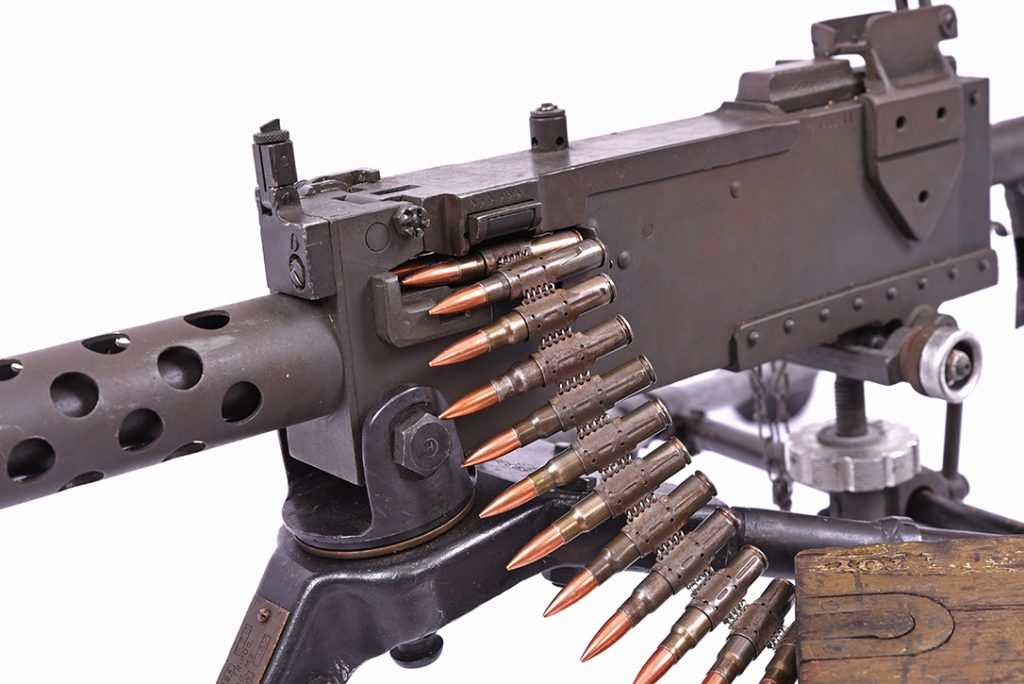
Advertisement — Continue Reading Below
Improving the Design
While the M1895 performed well, Browning continued to consider other designs and in 1903 filed a patent for a recoil-powered automatic gun—similar in concept if not actual design to Hiram Stevens Maxim’s machine gun. Both weapons utilized the principle of recoil operation, water cooling and forward ejection, but there were notable differences in the designs. Browning’s featured a sliding-block locking mechanism that saved weight and reduced the complexity of the operation while the Browning fed left-to-right opposite of the Maxim design.
Many of the nations of Europe, which were on a path to war, adopted variations of the Maxim and this included the British Vickers and the German MG08. Browning revisited his design in 1910 and built a prototype. With its water jacket and basic shape the similarities to the Maxim remained; yet at 103 pounds including the gun, tripod, water and ammunition it was actually lighter than the British or German models that weighed in at more than 137 pounds.
World War I
Browning was unable to take his design forward at first, but this changed when the U.S. entered World War I in April 1917. The U.S. arsenal was woefully lacking in machine guns, and those that they had were out modeled and out classed. The United States Army Ordnance Department, which had shown little interest in a new machine gun, realized a new model was required. Browning quickly arranged a test at the Springfield Armory in May 1917, and his weapon performed extremely well.
Advertisement — Continue Reading Below
The Browning-designed U.S. Model 1917, chambered in the M1906 .30-06 ball cartridge was adopted as the Army’s principal heavy machine gun. However, the M1917 saw limited service during World War I, but it wasn’t a fault of the design.
Production delays enables only about 1,200 of the new heavy machine guns to make it to Europe. Their only use came in the closing stages of the war. But the Browning design proved successful, and M1917 production topping more than 128,000 in total. The water-cooled machine gun would see use in World War II, Korea and even into Vietnam. It would also pave the way for an even more robust design, one that would change it from strictly a heavy machine into a versatile weapon.
Enter The Model 1919
Browning reconsidered his design, and one notable factor remained its weight. The water jacket, which cooled the barrel, meant that the heavy machine gun was heavy in weight as well as firepower. This is why similar designs such as the Vickers and MG08 were only used in fixed positions as defensive firearms.
Advertisement — Continue Reading Below
The Germans had developed the MG08/15 with a pistol grip and removable assault magazine to make it more compact but was still heavy—and despite what video games may suggest—it was nearly impossible to be fired on the move. Perhaps seeing that the next war wouldn’t be so static, Browning opted to make his machine gun more portable.
The result was the U.S. Model 1919, which was still chambered for the powerful and effective .30-06 cartridge. Unlike the other ground-mounted machine guns of the era, the M1919 featured an air-cooled barrel, which was heavier to reduce overheating but was easier to maintain in combat conditions than the M1917 machine gun or its water-cooled cousins.
By removing the water jacket, the machine gun team didn’t need to carry a condensing can, further making it more mobile. In its early design it still relied upon the bulky—and extremely heavy tripod—and also utilized a cloth ammunition belt. Similar in design to the Vickers ammo belt, these could get dirty and foul the gun, so it wasn’t just the barrel that was given a makeover.
Advertisement — Continue Reading Below
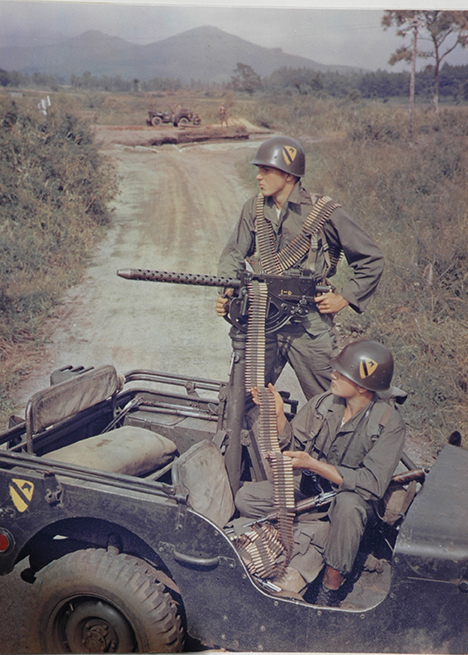
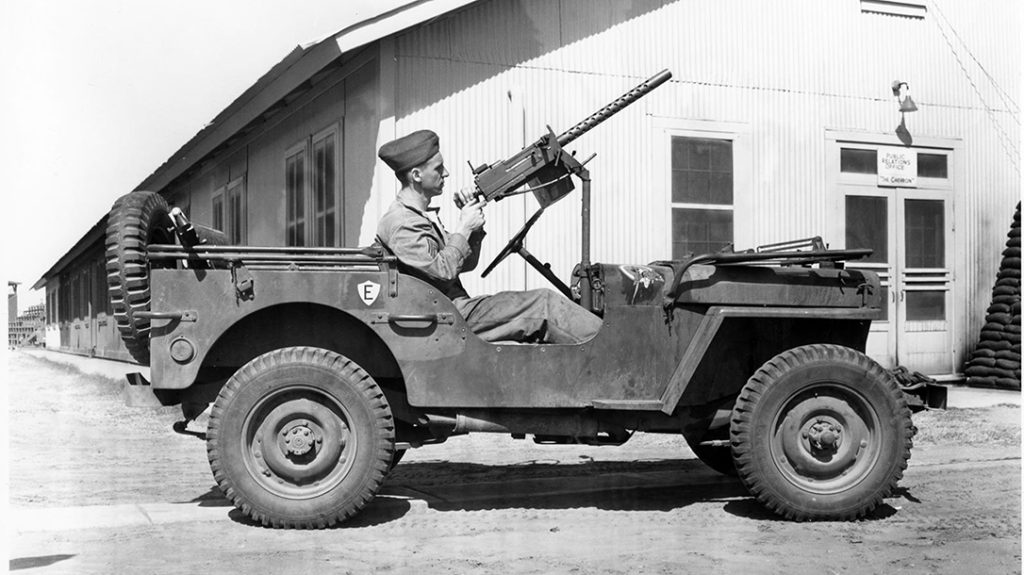
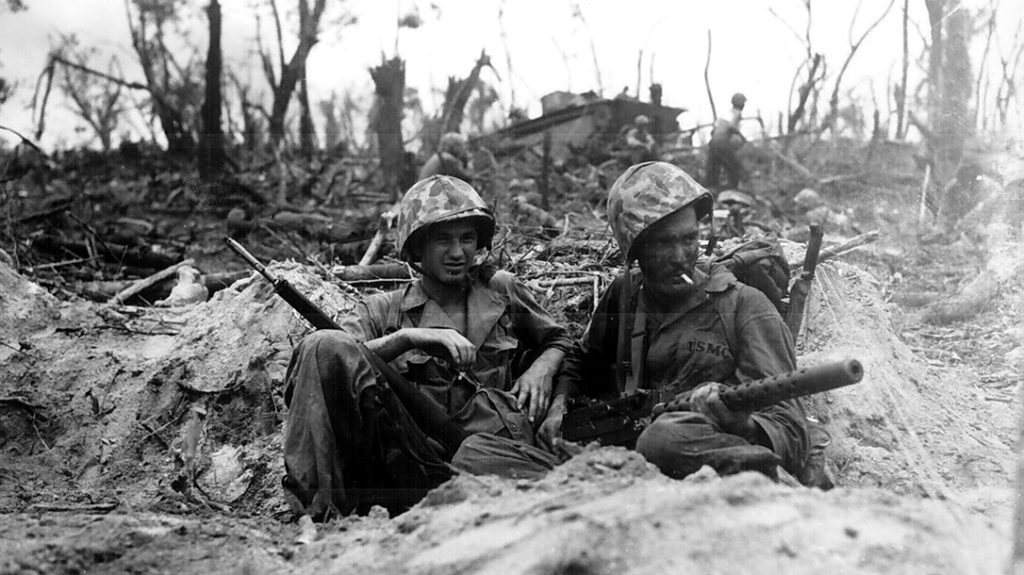
Advertisement — Continue Reading Below
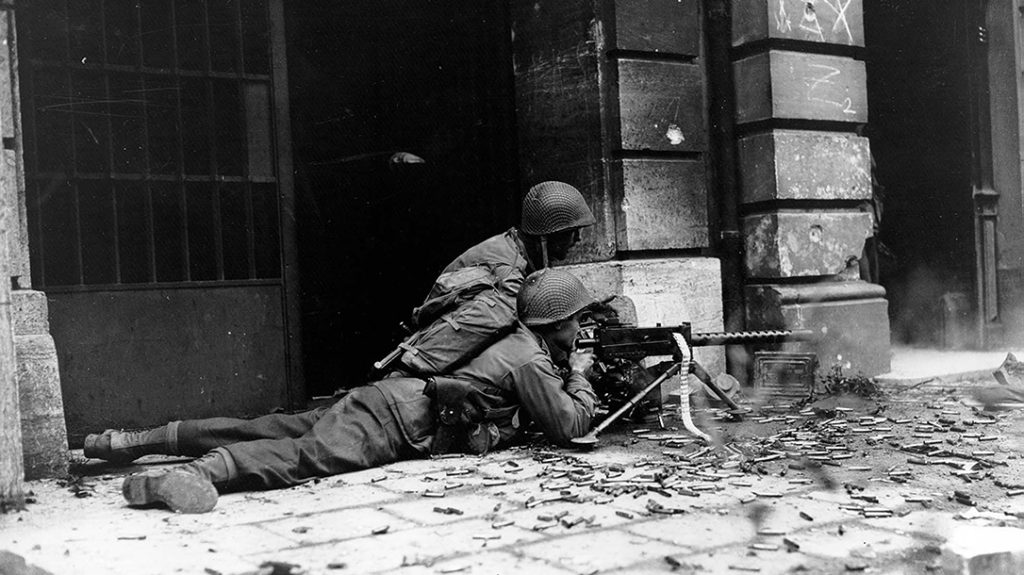
M1919 Belt, Tripod, Barrel
The M1919 eventually accepted a metal M1 link, the first in disintegrating belts. This provided the benefit of allowing a single round to hold two links together, with more added to make up a belt of any quantity of rounds.
By the outbreak of World War II, a new, smaller tripod became far more compact. This allowed the M1919 machine gun to take the role of a medium machine gun and serve as a company or battalion support weapon. It still required at least a two-man machine gun team. In most cases, a four-man team split the duty of carrying the gun and its ammunition. This included the gunner, who actually fired the gun but when advancing carried the tripod and a box of ammunition. The assistant gunner carried the actual weapon, along with the spare parts and tools. He would assist feeding the weapon while in combat. Two other soldiers in the unit would carry additional ammunition.
Advertisement — Continue Reading Below
To make it even more compact and maneuverable, the M191A1 version featured a lighter barrel and bipod. Meanwhile, the M1919A2 version, built specifically for calvary unites, utilized a shorter 18-inch barrel and a special tripod. However, this version never saw use in combat due to the changing role of “cavalry” in the U.S. Army.
M1919 Variations
The most common variant of Browning’s design was the M1919A4, which refined the holes in the barrel jacket as a way to reduce the weight. This version relied on a low-slung tripod for infantry but also fixed mounts on Jeeps, tanks and other vehicles.
A less successful variation, introduced in the latter stages of World War II, the M1919A6 attempted to offer more sustained firepower than the Browning Automatic Rifle (BAR). This variation featured a bipod similar to the one used on the BAR, along with a carry handle attached to the barrel jacket. The most notable differences were the addition of a metal buttstock and a lighter barrel with a muzzle booster. Unlike other versions, the M1919A6 featured a barrel that changed easily to reduce overheating.
Advertisement — Continue Reading Below
However, the M1919A6 at 32 pounds was heavier than the German MG-34 that weighed 26 pounds although the barrel changing wasn’t nearly as quick. It tried to turn the weapon into something it wasn’t—a light machine gun. John Browning, who had passed away in 1926, likely wouldn’t have approved of this variation as it didn’t improve upon his design in the least.
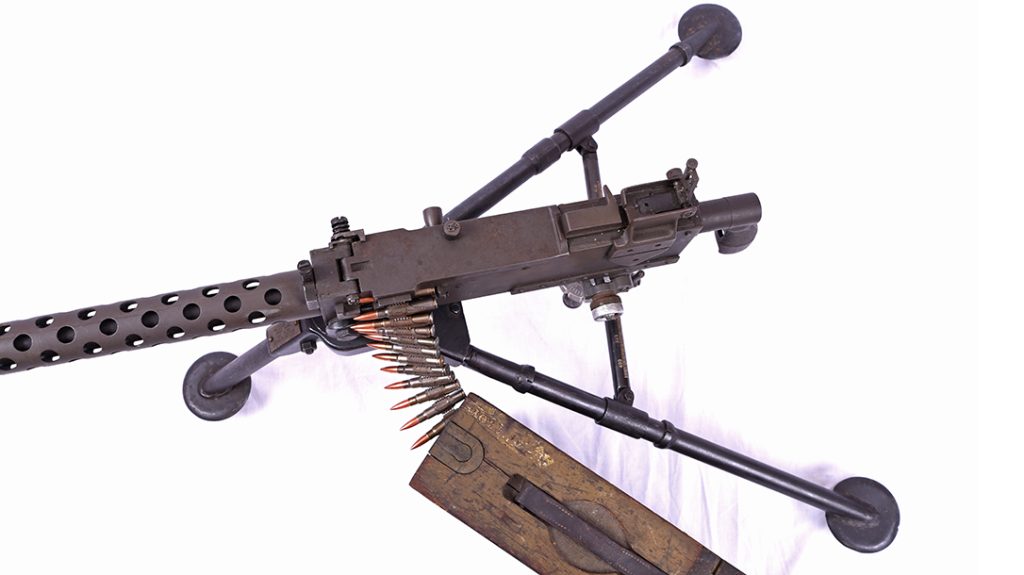
Aerial Combat
The version that the venerable gun designer might have liked was the .30 AN/M2 variation. It derived from the M1919A4, specifically for use in combat aircraft. It featured a thinner barrel to keep the weight down but had an impressive rate of fire of 1,200-plus RPM. The lack of sufficient firepower in the .30-caliber round provided its only drawback.
However, a heavier version was already an option. Seven years after his death, the Browning design upgraded in 1933 as the Browning .50 caliber machine gun. This weapon, like its .30-caliber version, remains in use to this day.
At 100 years old, the U.S. Model 1919 machine gun has left its mark in history. It served and continues to see use by nations around the globe. Meanwhile, civilian-friendly semi-automatic versions also find homes with gun owners. It is a testament to the Browning design that 100 years later it has left its mark. It has become an icon of infantry small arms.
BROWNING M1919 FUN FACTS:
- Designed: 1919
- Manufacturers: Buffalo Arms Corporation, Rock Island Arsenal, Saginaw Steering Gear (Division of General Motors)
- Produced: 1919-1945
- Number Produced: 438,971
- Weight: 31 pounds (M1919A4)
- Length: 37.94 inches (1919A4), 53 inches (M1919A6)
- Barrel Length: 24 inches
- Action: Recoil-Operated/Short-Recoil Operation
- Rate of Fire: 400-600 rounds per minute/1,200 rounds per minute (AN/M2 version)
- Muzzle Velocity: 2,800 feet per second
- Maxium Effective Range: 1,500 yards
